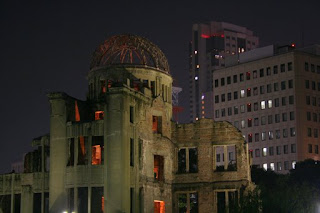 Hiroshima Now a Modern Metropolis
Hiroshima Now a Modern MetropolisSixth August 1945 is etched in many minds, the date when Honshu’s largest city witnessed the devastating and horrific effects of the atom bomb. Today millions visit it to pay their respects. Hiroshima on the western end of the Inland Sea has been re-born as a vibrant, bigger and brighter city and is eloquent testimony to a “never say die” spirit of it’s people. The phoenix has risen from the ashes.
Take the street car to the A-Bomb Dome, a symbol of the destruction wreaked upon Hiroshima, a UNESCO world heritage site. The main structure with the dome has survived. At night the dome is lit up as a constant reminder of the horrific attack.
Nakajima, an earlier urban district was converted into the Peace Memorial Park in 1949. It is dotted with a number of memorials A spherical clock faces three directions and is perched on a 20 meter high twisted tower of iron pillars. At 8.15 a.m. (the time the bomb fell) every day the clock chimes “No more Hiroshimas”.
The eternal Flame was lit on 1 August 1964 and will continue to burn till, “the last nuclear weapon is destroyed from the world”. Just a little behind the Eternal Flame you see the Cenotaph, shaped like an arch with a stone chest in the centre. The arch bears the inscription “Let all the souls here rest in peace, for we shall not repeat the evil”. The stone chest contains the names of all those who died because of the bombing. The Peace Memorial Museum is 2 huge buildings connected by a walkway. The East wing has displays on the after-effects of the atomic bomb, models of Hiroshima before and after, pictures, letters etc, even the letter that ordered the bombing. One display that speaks volumes is a wrist watch that stopped ticking at 8.15 a.m. The west wing has displays of a model of the bomb, the mushroom shaped cloud, burnt clothes, walls with glass splinters, bottles and boxes, twisted and melted, fused tiles-all poignant reminders of a horrible event. Large TVs screen films on the bombing and it’s aftermath. The corridor that leads to the exit is where you see a register of the names and photos of the victims. This Peace Memorial Museum wants to drive home the message of the horrors of the Bomb, “lest we forget”.
There is a positive side to Hiroshima as well. This is the power of life over destruction or nature’s way of renewing itself.
The children’s Peace Monument was inspired by Sadako, a 12 year old girl who died of leukemia, an after effect of the bomb. She started folding origami paper cranes hoping to get well. Paper cranes have since become a symbol of peace here and you will see countless colourful paper cranes scattered throughout the park.
 Of course the visit does not do too much for your appetite. Even so Hiroshima is famous for its sea food. It is also the “jumping off” point for several islands the most famous being Miya-Jima (pic on left). This is where the famous Itsukushima Jinja is located. The view of its red “Tori” (gate) standing in the misty shallows in front of the shrine is one of Japans most celebrated icon.
Of course the visit does not do too much for your appetite. Even so Hiroshima is famous for its sea food. It is also the “jumping off” point for several islands the most famous being Miya-Jima (pic on left). This is where the famous Itsukushima Jinja is located. The view of its red “Tori” (gate) standing in the misty shallows in front of the shrine is one of Japans most celebrated icon.For more information contact Japan National Tourism Organization, 10th Floor., Tokyo Kotsu Kaikan Bldg., 2-10-1, Yurakucho, Chiyoda-ku, Tokyo 100-0006, Tel: +80-3-3201-3331, Fax: +80-3-3201-3347, website: http://www.jnto.go.jp



No comments:
Post a Comment